Adam Yamey's Blog: YAMEY, page 241
April 8, 2012
Romantic development - comments please!
Someone on www.goodreads.com wrote;"FOR THE LAST TIMEAUTHORS, making your two main characters feel "unexplainablyattracted" to each other does NOT make up for lack of proper romanticdevelopment."
Am I achieving proper romantic development in the following excerpt from my novel, a work in progress?
It is 1869.
Jakob Kleinnoerdlinger has just spent 4 days crossing the Karoo, the desert in the heart of South Africa. He has reached the town of Graaff Reinet where he has just met Mr Frederiks, a timber dealer, with whom he plans to do business. This excerpt begins just after Jakob has been shown around the timber yard.
NOW SEE:
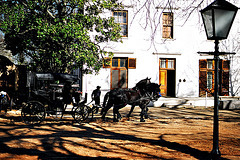
http://www.goodreads.com/story/show/2...
April 2, 2012
A worthy great grandfather
Franz Ginsberg and the ITO
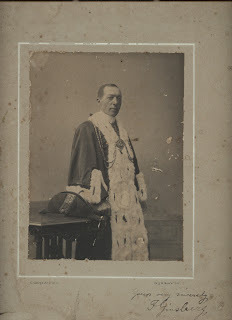
"Has the world forgotten the massacres in Kieff in 1880, 1881, and 1882,…, or in Kischinieff and Gomelin 1903? In Kieff the houses of Jews were fired and pillaged. The children weretorn from their mother's breasts and dashed to pieces before their eyes. Fourhundred souls were destroyed in two days. … Then at the massacre at Kischiniefflast year the young Jewish girls were outraged before the eyes of theirparents. One frantic woman tore herself from her captors and rushed to herdaughter's rescue, but a blow from the butt of a soldier's rifle scattered herbrains. The Pristav and the Politzmaister, with police and soldiery, looked onat the slaughter." Thus wrote theauthor Carl Joubert in 1905, after having lived for nine years in the RussianEmpire.
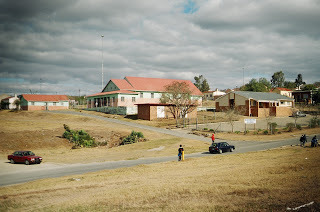 Ginsberg Township on the edge of King Williams Town was named in honour of the author's great grandfather Franz Ginsberg
Ginsberg Township on the edge of King Williams Town was named in honour of the author's great grandfather Franz GinsbergReports of atrocities such asthose reported by Joubert in 1905 were frequently published in South Africannewspapers including those which my great grandfather Franz Ginsberg (1862-1936)perused at his breakfast table in King Williams Town. Having left Beuthen inPrussia for British Kaffraria in 1880, he was by 1905 not only a prosperousindustrialist and the Mayor of King Williams Town, but also a Member of theLegislative Assembly of the Cape Colony. The reports of the massacres filledhim with concern for the fate of his co-religionists who had not been asfortunate as him to have been able to have found new home in a country wherethe Jew was held in as high a regard as the gentile. Maybe, it was such a considerationthat led him to take a leading role in the South African branch of short-lived Jewish TerritorialOrganisation ('ITO').
The ITO
In 1903, the British Government,sympathetic to the plight of the Jews in Russia and other parts of the east ofEurope, offered the Zionist Congress territory in British East Africa as anational home and country of refuge for the persecuted Jews. This scheme knownas the "British Uganda Programme" captured the imagination and approval of thewriter and Zionist activist Israel Zangwill (1864-1926). At the Sixth ZionistCongress held in Basel in 1903, Theodor Herzl (1860-1904), the father ofZionism, proposed accepting the British offer. He had recently visited Russia and seenfor himself the plight of the Jews there, and this had impressed on him theurgency of finding a refuge for them. The Russian Zionists were notenthusiastic: they were prepared to consider only Palestine as the homeland for the Jews. Avote was held. However, following a vote a majority of the delegates at theCongress favoured sending an expedition to examine the territory offered by theBritish. A year later, Herzl died.
Atthe Seventh Congress, held again in Basel, heldshortly after Herzl's death, the delegates learnt that Uganda wasunsuitable for settlement because of the wild animals there and also because itwas considered that the native Maasai would be too hostile to have asneighbours. They then voted to consider that the only place that could beconsidered as a National Home for the Jews was Palestine. No other place wouldbe acceptable.
This decision caused a group ofmainly Western Jewish delegates led by Israel Zangwill to lose patience with,and to leave the Zionist movement and to form a breakaway organisation, the ITO.Its objective was to seek an 'empty' territory anywhere in the world whichcould become a safe refuge for the persecuted Jews.
The ITO in South Africa
In July 1905, the First SouthAfrican Zionist Congress was held in Johannesburg. One of its resolutions wasto instruct the South African delegates who would be attending the forthcomingSeventh Zionist Congress to support the granting of power to consider any offer made by any government of asuitable piece of land on which an autonomous Jewish colony could beestablished. The ITO whose formation followed the Seventh Congress found favourwith many Jews - Zionists and others - in South Africa. Soon after the congressheld in Johannesburg, branches of the ITO began to be opened all over SouthAfrica.
One of these opened in Cape Town.It was actively supported by leading Jews such as the Reverend AP Bender(1863-1937) and also by leading gentiles such as the novelist Olive Schreiner(1855-1920) and her brother the politician and former Prime Minister of theCape Colony, WP Schreiner (1857-1919). Olive addressed a meeting of the ITO in1906 with the words: "I would welcome theexiled Russian Jew to South Africa, not merely with pity, but with a feeling ofpride that any member of that great, much-suffering people, to whom the worldowes so great a debt, should find a home and refuge among us; and with thecertainty that however broken, crushed and dwarfed he might appear to be by the long ages of suffering and wrong whichhave passed over him, he would recuperate and rise…" Schreiner's words were prophetic: many Jewsfrom Eastern Europe did come to South Africa where they did indeed "recuperate and rise". Amongst the greatand good who heard these words at the meeting held in the Cape of Good Hope Hallon the 6th of July was my great grandfather Franz Ginsberg.
King Williams Town.
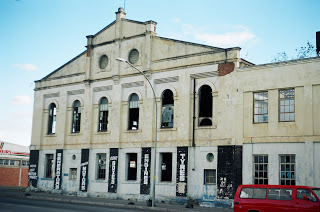
The remains of Ginsberg's factory in King Williams Town, 2003
A month after the Zionists hadassembled in Johannesburg, and a year before heattended the ITO meeting in Cape Town,my great grandfather Franz Ginsberg was elected to serve another term as Mayorof King Williams Town. In February 1906, he chaired a public meeting in KingWilliams Town about the ITO. It was the first time that this secularly-orientedman had presided at a specifically Jewish meeting. At this gathering a MrsAuerbach spoke about the ITO. After she had given a lecture about the ITO,Ginsberg's brother-in-law Siegfried Salamon (1870-1913) proposed: "That this meeting of the Jewish people andsympathizers of KWT is of the opinion that the only practical solution of theJewish problem is the procuring of a colony upon an autonomy basis for thoseJews, who cannot, or will not, remain in the land in which they at presentlive, and pledges itself to give moral and material support to the ITO".This motion found favour with those attending the meeting. A week later the local newspaper noted thatboth Ginsberg and Salomon had made sizeable contributions to the local RussianJews Relief Fund.
On Tuesday, the 22ndMay 1906, Franz Ginsberg left King Williams Town on the 6.42 pm train bound forCape Town via Aliwal North, and Kimberley. He arrived at the capital in timefor the opening of Parliament three days later. It was whilst he was takingpart in Parliamentary debates that he attended the ITO meeting mentioned above. Several months later, having returned toKing Williams Town, Ginsberg attended a meeting the town's own sympathisers ofthe ITO. This was held in mid-October at the Sons of England Hall.

Table Mountain, Cape Town
The meeting was chaired bySiegfried Salamon. Franz Ginsberg delivered a very eloquent address on the aimsand object of the ITO. First, he pointed out the differences between the ITOand the Zionists. Whilst he was in sympathy with the Zionists, who preferredPalestine to any other country, for they regarded that to be due to thespiritual longing of the Jew for the Holy Land, he regarded the TerritorialScheme to be a more feasible and practical one. He continued his speech bysaying that although the Jews in South Africawere in the main law-abiding and good, it was most important that they behaved evenbetter than others in the country, so as to be able to dispel the prejudice andsuspicion that existed in certain quarters against the Jews who happened tocome from Russia.At the end of his speech, Ginsberg urged the necessity of forming a branch ofthe ITO in King Williams Town. Following this, about forty people enrolled tobecome members of the ITO. My great grandfather was elected president of thelocal branch, and Salomon, Vice-president. A week later, Ginsberg addressed alarge meeting in East London in support of the objects of the ITO.
Shortly after the meeting held inEast London, a branch of the ITO was opened in that port. However, after thisGinsberg seems to have had no more public involvement in the ITO. The mostlikely explanation of this is that by the end of 1906, interest in the ITObegan to diminish rapidly amongst the Jews of South Africa .
Assimilation.
Franz Ginsberg came to SouthAfrica in 1880, aged sixteen. He came from a religious background. His father,the brilliant mathematician Dr Nathan Ginsberg (1840-1890) turned down theopportunity to take up a professorship at least two German universities becausehe felt unable to abandon Judaism and to be baptised, as was required of senioracademics in those days. Instead, he helped found a Jewish school in Beuthen. Franzcame to South Africa partly to make his fortune but also to escape therestrictions imposed on Jews in 19th century Germany. Like many of the Jews who came from Germanyto South Africa in that time, he felt that the way to become acceptable in theBritish-orientated society was to assimilate - to seem less foreign to hisBritish neighbours. This included the suppression of outward manifestations ofhis inner religious beliefs. In this context, it is interesting that one of thevery few public manifestations of his religion was his active involvement inthe ITO - an organisation that attracted as many gentiles as it did Jews. Thus,he supported a Jewish cause without risking undue public exposure as aJew.
In all fairness, my greatgrandfather was a supporter of all the oppressed, regardless of their race,creed, or colour, and is still well remembered and honoured (for example by the Steve BikoFoundation in King Williams Town) for his championship of the welfare of theblack African.
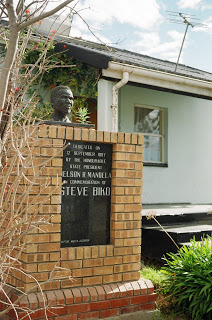
Monument to Steve Biko outside the house in Ginsberg Township (close to King Williams Town), where he lived under house arrest.
April 1, 2012
ALIWAL: my first novel
Henry Bergmann lives on the frontier of the Cape Colony in Aliwal North, the town he helped to establish in 1849.
He is the richest man in the town, and probably one of the wealthiest in the Colony.
His integrity and concern for others has gained him positions of responsibility including managing the town's bank.
He meets a respected gold prospector, who invites him to join a venture that promises to yield rewards beyond his wildest expectations .
Although he has enough already, he would like to use the promised riches to improve the prosperity of the town, to develop it into the pride of the Colony.
He accepts, travels north into the Transvaal, and becomes entwined in something that will lead him gradually, but inexorably, towards a tragic fate.
Fact and fiction are interwoven in ALIWAL, my first biographical novel.
ISBN: 978-1-4461-8322-9
Available as a book or an ebook on: www.lulu.com, and also on Amazon, where a Kindle version is on offer.
March 31, 2012
Restaurants, hotels, and other attractions
Over the past few years, I have been writing brief reviews for hotels, restaurants, and tourist attractions. You can read these on http://www.tripadvisor.co.uk/members-reviews/barklyeast .
I hope that some of these may be of use to you!
March 29, 2012
Work in progress
Young Jakob,who left his native Bavaria in 1863in order to seek his fortune, is living many thousands of miles away,across the Equator in southern Africa.
He marriedthere, and his family is growing.
Now, it is 1877.
The Zulus are strugglingwith the British in an attempt to keep control of their lands in Natal.
Elsewhere,in the neighbouring Cape Colony, prospectorsare filling their pockets with diamonds.
Sadly, none ofthese sparklers has ever reached Jakob, who would certainly have known how tomake good use of them.
This does notworry him particularly, because all that he asks of life is to care forhis young family, and to enjoy the occasional glass of brandy.
But now,disaster has struck.
He has beenforcibly separated from his loved ones, and is languishing in a cell behindbars.
Why has hebeen incarcerated?
And will he beable to find a way of getting out?
Mynew novel, set largely in the Orange Free State, is a tale very loosely based on episodesin the life of one of my colourful ancestors.
html hit counter I have recently joined http://www....
May 29, 2011
A collection of my mini-films
April 12, 2011
What readers think about my novel, "ALIWAL"
"Finished Aliwal. Loved it. When's the next one due?" (R. Zainulbhai)
"This book brought back some interesting memories of visits to the town of Aliwal North both as a child and as an adult. As a child I visited the old Bergman store many times and I was reminded of this as I read this fascinating piece of personal history. I commend this book to others seeking to know more about their forebears, Adam Yamey's research into his relative is a great piece of detective work and the story is well told here." (PG Cox, writing on Amazon.com)
"... I recommend this book to all who are interested in German Jewry, early South African colonial history, and to those who just want a good read." (S. Issroff writing in 'Shemot')
"It is well written and reads easily thanks both to the pleasant linearity of the plot and the large use of dialogues.The reader is soon captivated by the adventurous story of its hero and at the end wonders how such a smart and successful man might have so easily become the victim of some mean swindlers and fall therefore from the highest peaks of prosperity and reputation to the desperate situation which drove him to suicide.I congratulate you upon the result of your patient and interesting research into the tragic end of your unfortunate ancestor."
(A Bagiotti, editor)
January 30, 2011
Trip to northern Karnataka, 2009
December 4, 2010
An Event in AUGSBURGPoster 5Poster 4Poster 3Poster 2Poste...
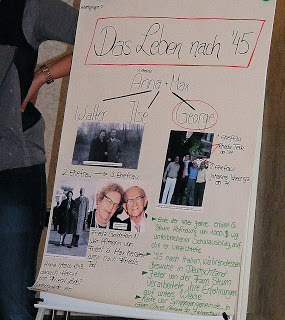 Poster 5
Poster 5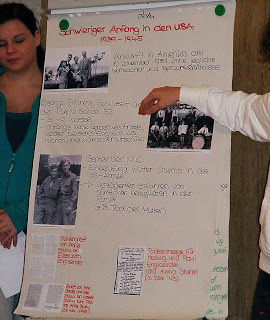 Poster 4
Poster 4 Poster 3
Poster 3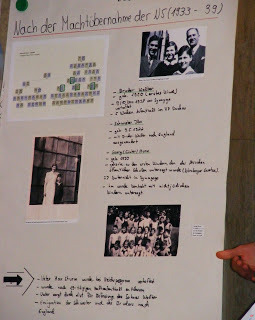 Poster 2
Poster 2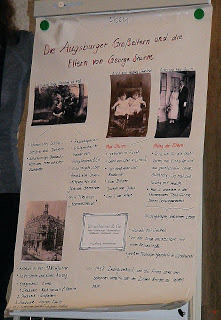 Poster 1
Poster 1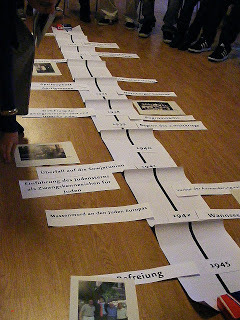
Timeline
Monday, the 15th November 2010, AUGSBURG
I woke early. The sun was still shining. After breakfast, I wandered through the old town, stopping at the Barfüsser Church. The church is completely surrounded by other buildings above which it projects. Although it claimed to be closed, I entered without difficulty. I continued my journey to the synagogue, an impressive building in Halderstrasse whose construction was assisted with substantial financial donations from the Sturm and Steinfeld families. I noticed that most of the doors in the building had bilingual signs: in German and Russian. Some years ago, a history teacher in Melsungen (in Hesse) surprised us by telling us that the Jews were the fastest growing group in Germany. The influx of Jews from the former Soviet Union accounted for this.
George and Max were already there, as was Souzana Hazan and Frau Schönhagen. Diane and her son Alex had left for Paris. Soon, twenty students from the Simpert-Kraemer Gymnasium in Krumbach arrived with their two teachers. The kids were aged from 15 to 17, and had special interests in history, although their faces did not betray this when we all sat in a large circle in one of the rooms in the synagogue.
A long strip of paper was placed like a diameter inside the circle. It was a time line with dates, such as 1871, 1917, 1932, 1938, 1945, and others in between. Rectangular scraps of white paper lay on both sides of the time line. Each child was told to pick up one of these scraps, and to turn it over. Each one bore a historical event, such as 'Wannsee Konferenz", or 'Weimar Republik'. They then placed their pieces of paper where they thought it should be on the time line. Although one girl thought that the Weimar Republic began in 1945, most of the children placed them in the correct places.
Next, Souzanna Hazan read out a history of the Sturm/Steinfeld/Englander families. As she did so, copies of photographs of various family members were handed around the circle of children, and then carefully placed in the relevant points on the time line. Thus the history of the family was placed alongside the history of modern Germany. After this, the time line was divided into 5 sections. Each group of four students had to choose a section and then retire to a work table that contained materials relevant to that section. We adults retired to the Jewish Museum shop across the hallway to drink coffee and chat. After about 45 minutes, the school children joined us, and refreshed themselves with cold drinks and butter filled pretzels. Then we returned to the room where the seminar was being held.
Each group of four students had produced posters illustrating the period they had chosen. One by one the groups of four students presented, and explained what was on their posters (illustrated above).
When a group had given their presentation, they asked George questions that had arisen in their minds whilst they had been preparing their posters. I cannot remember all of their questions but two linger in my mind. Could George speak English when he stepped off the boat at Hoboken? No, he could not, but by the end of the year he was the best speller (of English) in his class. Another child asked whether he helped in the family shop in Augsburg. George pointed out that he would have been little help as a five year old in the sophisticated cloth store, probably a hindrance. He did however help his grandfather gather chestnuts when they walked together in the Siebentischwald Forest on the edge of the city. These, he was told, were good for Opi's rheumatism. The question was interesting because farmer's children such as were attending the seminar would have found it normal to have to 'muck-in' when the family needed extra hands. George coped beautifully with their questions, and rapidly developed a great rapport with the children. It seemed to me that during the three hours that they had spent working on the family history, the children had begun looking at George's family's life and difficulties as if they were their own. After posing with the class for photographs, each member of the class shook each of our hands before leaving for their hometown.
[image error] html hit counter



